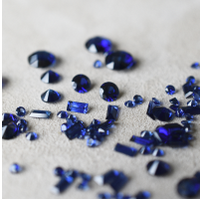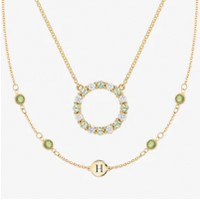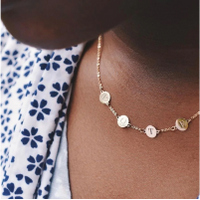Free Ground Shipping on orders $150+
Free 2-Day Air on orders $495+
Free Ground Shipping on orders $150+ | Free 2-Day Air on orders $495+
Popular Search Terms
Sorry, nothing found for ""
- EUR
- USD $
- AUD
- CAD
- GBP

- HAVERHILL
Jewelry Terms to Know
When we shop for jewelry, we're immediately attracted by how the piece looks – then we read ahead to find out the details. When you read about an item on our website, you'll find that there may be some terms that you're unfamilar with. What, exactly, is a bezel? What do we mean by 14k gold? And what's a bale?
We’ll break it down for you so you can shop 'til you drop and maybe impress your girlfriends at your next wine night.
14k gold
Ladies, we all know this one, but for men who are first-timers, we can help you out.

Gold is an incredibly durable metal, but it's too soft to be used by itself in jewelry, so it's alloyed (mixed) with other metals to give it more strength. The amount of fine metal in an alloy is measured in karats. Fourteen-karat gold contains 14 parts pure gold and 10 parts other metal alloys. It's the most common gold used for jewelry, valued for its luster, color, durability, and affordability. Highly scratch-resistant, it's ideal for everyday wear.
Bale
Also spelled bail (not to be confused with bailing on the blind date you have scheduled this weekend), a bale is the metal loop that attaches a gemstone or other pendant to a chain and allows it to slide back and forth.

Bezel
A bezel is a jewelry setting that holds gems in place with a raised rim that comes ever-so-slightly over the edges of the stones. It's a protective setting that helps keep the stones' edges from being chipped.

Box clasp
A box clasp is a very secure closure for a bracelet. It consists of a metal wedge (sometimes called a tab or tongue) and a "box." The wedge compresses when it slides into the box and then expands, so it "clicks" into place. A safety catch on the side of the box offers a second layer of security.
Briolette
Briolette is a type of gemstone cut. A briolette-cut gem is one that's cut into square or triangular facets (see below). Our 4mm and 6mm briolettes are checkerboard, cut into tiny squares.
Cable chain
One of the most common chain styles, a cable chain is strong, durable, and made from individual round or oval links that are soldered together in an identical pattern. (Our Classic and Saffron chains are cable.)

Emerald cut
Taking over the bridal world right now (rightfully so) and originally intended for Emeralds, this type of gemstone cut is popular now for many other gems, especially Diamonds. An emerald-cut gem is octangular, featuring long, parallel facets that create a "hall of mirrors" effect. It's the cut used for the center stone in all our Warren jewelry. (She's dreamy, trust us.)
Facet
A facet is the flat side, or face, of a cut gemstone. Different gemstone cuts produce any number of facets in varying shapes and sizes.
Lobster claw
We love to keep things on theme with our New England aesthetic. A lobster-claw clasp is an elongated loop with a spring-loaded lever. Once you let go of the lever, the clasp closes automatically. Lobster-claw clasps (named for their "pinching" action) are used often because they're very secure and easy to open and close.

Paperclip chain
An elevated version of the paperclip links you used to create in elementary school (kidding). A paperclip chain is a cable chain whose links are elongated, and may be nearly rectangular in shape. A paperclip chain often has a light, airy quality to it (see for yourself).

Pavé
A pavé setting is one in which smaller gems are placed so closely together it looks as though the piece has been paved with them. Very little, if any, metal can be detected between the stones. A pavé setting adds a wonderful note of sparkle to any piece.

Prong
If you prefer maximum shine, a prong setting is the one for you. In this setting, the gem is held in place by three or more prongs (sometimes called tines) that extend slightly over the edges of the stone. With a prong setting, virtually all of the gem is exposed to light, allowing for maximum shine.

Rolo chain
A rolo chain is another variation of the classic cable chain, with links that are rounded on the outside and flat on the inside. Our popular Mia chain is a rolo.
Round cut
Once used exclusively for Diamonds, but now popular for other gemstones, a round cut creates symmetrical facets that maximize the stone's reflection of light. (Ladies, take note for engagement rings.)

Setting
A setting is the metal base that holds a gemstone. Examples include bezel and prong settings.

Shank
The shank of a ring, also called the band, is the part that goes around your finger. A splint shank, as seen in our Warren Rings, separates into two parts, creating a larger area to hold the center gemstone.
We hope you've enjoyed this mini glossary of jewelry terms, and that it helps with your next treat-yourself purchase. Any confusion? Just add to cart and trust that it'll look gorgeous on you.
If you have any questions about these terms or others you see on our site, our wonderful Customer Care team is happy to help.

We hope you've enjoyed this mini glossary of jewelry terms, and that it helps with your next treat-yourself purchase. Any confusion? Just add to cart and trust that it'll look gorgeous on you.
If you have any questions about these terms or others you see on our site, our wonderful Customer Care team is happy to help.




























































































